Complete Guide to Climbing & Bouldering Technique
Climbing is an exhilarating and physically demanding sport that requires strength, flexibility, and technique. Whether you’re a beginner or an experienced climber, there are always new techniques to learn and ways to improve your performance.
This guide goes over the fundamental techniques for beginners and explores more advanced techniques for experienced climbers.
Every technical move has an underlying article that tackles the technique in-depth. So do use the links if you need more information on how to perform and how to practice a certain move.
Technique Fundamentals for Beginners
Starting with the basics is essential for all climbers, no matter their level of experience. Mastering the fundamentals before moving on to more advanced footwork techniques will give you a better foundation as opposed to skipping the foundation and going straight to performing advanced ones with improper technique.
Here are five fundamental techniques that every beginner should know:
Use your toes!
Instinctively, beginner climbers tend to use the entire surface of their feet when placing them on a hold. Having so much contact on a foothold adds a feeling of security. However, it gives climbers next to no leverage while climbing.
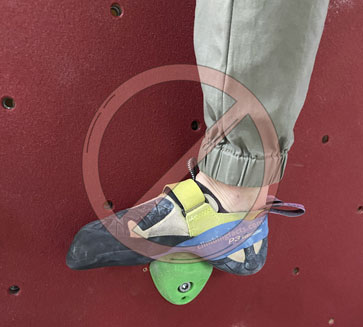
This is improper technique. You are better off using your toes instead, this is known as ‘Edging’.
Edging refers to using your toes to make more accurate foot placements. This has several benefits:
- Increased Precision: By using only a small part of your foot, you can more accurately place your weight on small or narrow footholds, which can make a big difference when tackling challenging routes.
- Improved Balance: By maintaining a narrow stance and placing your weight precisely over your feet, edging can improve your overall balance and stability while climbing.
- Enables Hip Twist: Edging allows for greater flexibility in your leg placement on footholds, enabling the use of the ‘hip-in’ technique which can offer advantages over the traditional ‘hip square’ method of climbing.
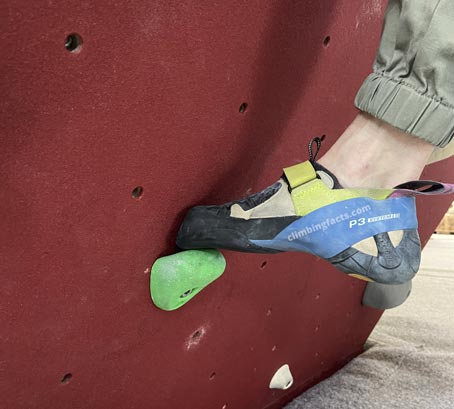
🤓 To ensure you always Edge Correctly (and don’t need adjusting), always look down at your feet before placing the foot down on a foothold.
When edging, it’s important to use the appropriate part of your shoe for the hold you’re standing on. For example, you might use the inside edge of your shoe for a hold that is angled inward, or the outside edge for a hold that is angled outward.
👉 Inside Edge
Inside Edge refers to edging using your big toe.
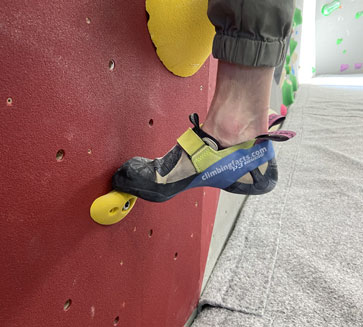
👉 Outside Edge
Outside Edge refers to edging from the outside of your toebox. This is the area around your smaller toes.
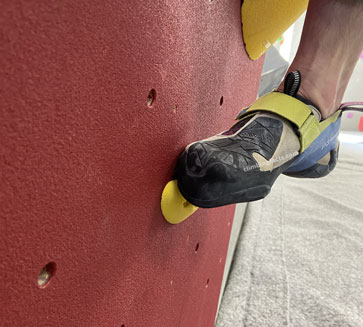
🤓 Foot placements should be active, not passive.
Straight Arm Hang
A common mistake made by beginner climbers (and sometimes even intermediate climbers when pushing their limits) is to bend their arms while climbing, resulting in excessive stress on their arm muscles. This is referred to as “T-Rexing,” where climbers rely on their arm strength to support themselves. This type of improper form leads to fatigue.
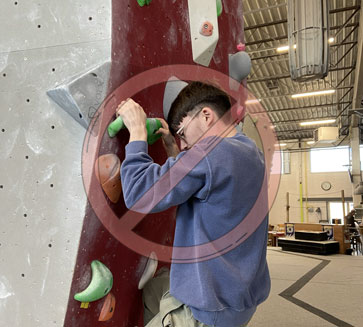
A more efficient way of climbing is hanging from a hold with arms straight. This forces your larger lower-body muscles to initiate moves over your arms, conserving energy and reducing fatigue.
Notice how I’m hanging from my arms and initiating movement from the legs.
It takes a while to get fully accustomed to the Straight Arm Hang, and you might even have to drop some grades just to add it to your move set, but once it becomes muscle memory, you will be a more efficient climber. As an added benefit, learning to initiate moves from the legs will unlock a bunch of new techniques!
Climb using Opposite hand and foot
Alternating movements between your right and left hand and foot is the optimal way of climbing. This technique ensures balanced weight distribution across your body and provides increased stability on the rock.
While climbing, you should always try to enforce the rules of contralateral movement. When this rule is broken, and the same hand and foot are used, you will peel off the wall.
This effect is known as a Barn Door because it describes your body opening up like a door after you have two points of contact on the same side. To avoid this effect, always climb with contralateral movement.
👉 Exceptions
Climbing is full of exceptions. Sometimes using opposite hand and foot isn’t possible, and the route forces you into a same hand and foot position. At this point, you can use technique to fight the Barn Door.
Using a foot swap can help combat a barn door. In this case, a simple Foot Swap allows me to re-establish Opposite Hand and Foot.
Another way to combat the barn door is by using a Back Flag. By swinging your leg back, you are pushing your Center of Gravity back inside your Base of Support.
Transition Moves for the Feet
During traverse routes, when the footholds deviate away to one side instead of going up vertically, you’ll have to use transition moves. Furthermore, these transition moves go hand in hand with more advanced movements such as the Back Step and The Outside Flag.
👉 Foot swap
The Foot Swap involves replacing one foot on a foothold with your other foot, typically when using the “hip-in” climbing technique. This move requires precision and coordination to pull off and is a crucial part of developing efficient climbing movements.
👉 Stepping Through
The Stepping Through technique is a variation of the Foot Swap that is commonly used when climbing on overhanging terrain. This move requires the climber to cross one foot over the other to reach a higher hold, instead of simply replacing one foot with the other. The Stepping Through can be more efficient than a Foot Swap as it requires fewer moves to be made, but it also demands a bit more flexibility
Do you notice how I’m making use of the outside edge during my crossover? This crossover also naturally pulled me into a Back Step position (hip in, knees face the same way) and I balanced my body out with an Outside Flag (my right leg ensures balance). These are advanced techniques that are coming up later.
Transition moves for the Hands
👉 Matching
Matching is a fundamental climbing move that involves placing both hands on the same hold. Sometimes the route forces you to make an obvious match; other times, you may choose to use it to reset your sequence or as an intermediate step if you don’t have enough reach to complete the next move.
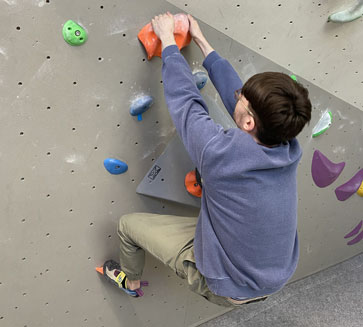
Most bouldering gyms will require you to match the final hold, to finish the boulder problem.
👉 Bumping
Bumping involves moving a hand to a new hold on the same side of your body without switching sides. This technique can be useful when the route breaks the traditional left-hand-right-hand sequence and you need to move your hand to a new hold in a more direct line. Bumping can also be used to reset your hand position for the next move or to reach a hold that would be difficult to get to with a standard hand-switch.
👉 Crossover
The crossover is a move in which a climber crosses one hand over the other to reach the next hold. This technique is often used during a climb when the next hold is located off to one side. Instead of matching hands on the current hold and then resetting the sequence, a crossover can save a move and be more efficient.
Footwork Technique 101
Smearing
Smearing is a basic technique that is used when a route lacks footholds. During a smear, you place the rubber of your climbing shoe on the wall and press down on your foot. The rubber will stick to the surface of the wall if you press hard enough, allowing you to move on the wall without a foothold.
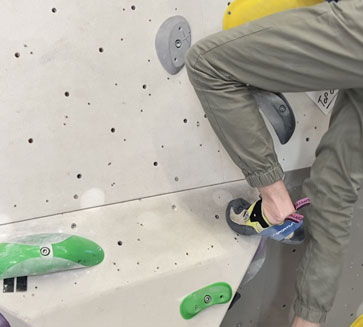
Smears are most commonly used on slab problems but translate well to other terrains as well.
Rockovers
A Rock Over is a climbing move where you transfer your weight over a high foothold. This is a basic, and instinctive move that has quite a bit of application in climbing. Rockovers are especially common on the slab wall.
The Back Step / Drop Knee / Hip In
There are several names for the climbing technique known as the Back Step. Some coaches refer to this move as a “Twist Lock” others may prefer the descriptive term “hip in climbing” and some will go as far as to refer to every Back Step move as a Drop Knee.
It’s a bit confusing. What you should know about the Back Step is that it refers to climbing with one hip turned into the wall and both knees pointing in the same lateral direction. This gives the climber a range of benefits such as extended reach, more balance, and energy preservation.
The Back Step is especially useful when climbing steep terrain but translates well to other types of climbing as well.
Notice how I’m pairing a Back Step with an Outside Flag. These two make an exceptional combination.
Flagging
Flagging involves extending one leg out to the side to maintain balance and control while climbing. This is a fundamental footwork technique that greatly increases a climber’s efficiency and control when mastered.
Let’s look at the different types of flagging moves.
👉 Outside Flag
The Outside Flag is the most common type of flag, and can only be used in an Opposite Hand and Foot position.
Notice how I’m pushing from my flagged leg to create momentum. Flagging is not just for balance! Use that leg.
👉 Inside Flag
The Inside Flag is a lesser common type of flag that is used to establish control during same hand and foot position.
👉 Back Flag
Similar to the Inside Flag, the Back Flag can also be used to establish control during same hand and foot position.
The Heel hook
The Heel Hook is a climbing technique in which a climber uses their heel to pull themselves up from a high foothold.
The Toe hook
The Toe Hook is a technical move where the top area (not just the toe) of a climbing shoe is used to maintain control on the wall. Toe Hooking is most commonly used to establish control from a bad handhold. If a sloper is too much for you, try to find a toe hook to help you stick to the wall.
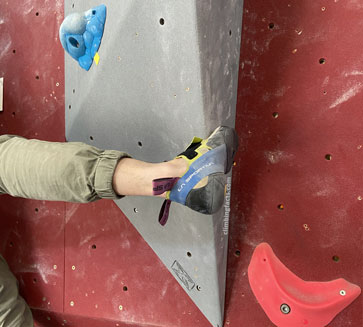
Dynamic Climbing Moves
Dynamic climbing is a style of climbing that involves explosive movements. Such movements are useful during routes in which holds seem too far to reach statically. Dynamic moves are generated from the legs and thus this type of climbing is often preferred to preserve energy over the more static style of climbing.
When it comes to dynamic moves, two moves stand out: the Deadpoint and the Dyno.
Deadpoint
The Deadpoin is a dynamic movement in which a climber leverages momentum to reach a far-away hold. To perform this move, the climber sinks down into a crouched position before pushing from the feet to explode towards a handhold.
During this move, the climber reaches a point where they are weightless, which is referred to as the Deadpoint, hence its naming.
Dyno
A dyno is a dynamic movement in which all limbs are cut loose from the wall and the climber leaps towards a handhold. Dynos are common in commercial climbing gyms and frequently used to entertain the crowds at bouldering competitions but are rarely seen outdoors.
Use Training Drills to practice technique
Training Drills are by far the best way to improve your climbing technique and become a more efficient climber. If you’re serious about improving your climbing technique, I highly recommend you check out our article on training drills below.
